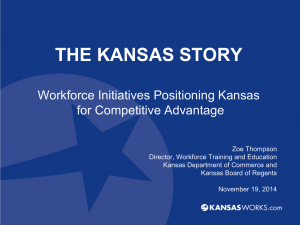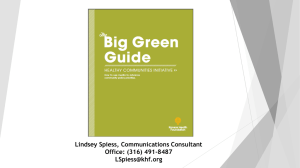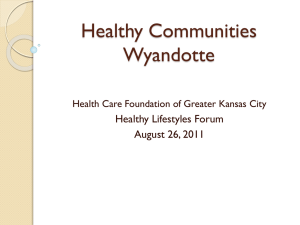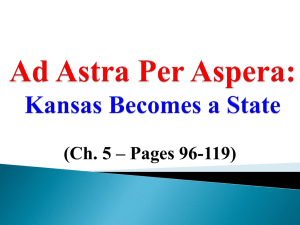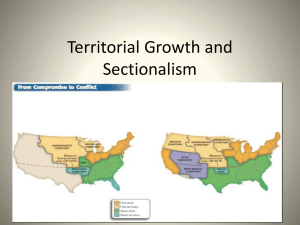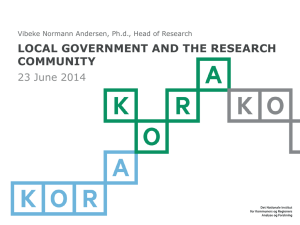2012 Firefighter Relief Act Seminar
advertisement
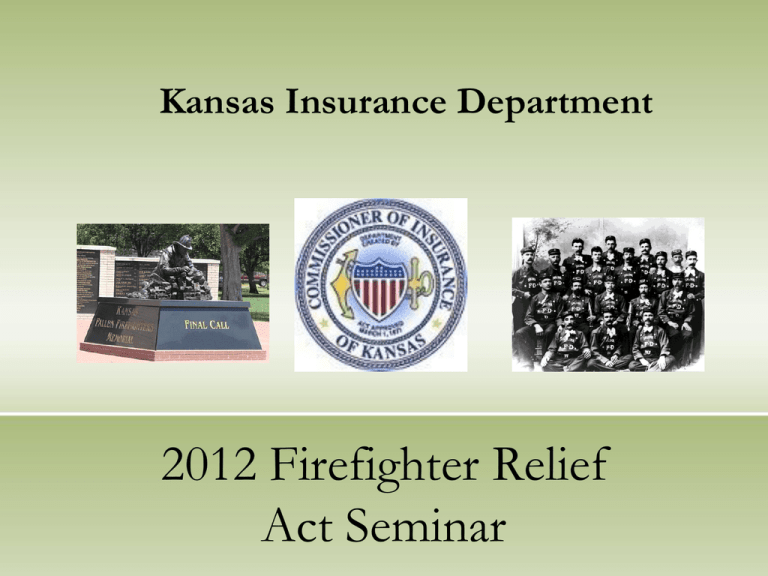
Kansas Insurance Department 2012 Firefighter Relief Act Seminar Agenda • • • • • Contact Information FRA Program Totals K.A.R. 40-10-16 Revised FRA Handbook Kansas Open Records Act • • • • • • Purpose of KORA Records Subject to KORA Public Agencies Subject to KORA Right of Public to Inspect Procedures for Obtaining Access Records that may be Closed • Insurance • • Term Life Insurance Permanent Life Insurance My Contact Information John Boyd jboyd@ksinsurance.org FRA Administrator Phone # (785) 296-7831 Kansas Insurance Department FAX # (785) 291-3673 420 SW 9th St Topeka, Ks 66612 Website: www.ksinsurance.org FRA Training Schedule for CY2012 July 7, 2012 Fort Riley KSFFA Fire School April 14, 2012 St Francis KSFFA Fire School Nov 3, 2012 Larned KSFFA Fire School April 27-30, 2012 McPherson KSFFA Annual Conference Mar 15-18, 2012 FRA Information Booth SCAFFA Jan 21, 2012 FRA Annual Seminar May 31-June 3, 2012 Labette Fire School CY 2011 Firefighter LODD (USA) total 81 • Classification (1/1/20-11 to 11/30/2011): • • • • 47 Volunteer 24 Career 3 Wildland Part-Time 1 Paid-on-Call • Type of Duty (1/1/20-11 to 11/30/2011) : • • • • • • • 22 On-Scene Fire 19 After 11 Other On-Duty 9 Responding 7 Training 5 On-Scene Non-Fire 2 Returning Cause of Fatal Injury (1/1/20-11 to 11/30/2011) # (44) (11) (5) (4) (4) (2) (2) (2) (1) Cause Stress/Overexertion Caught/Trapped Struck by Vehicle Collision Other Fall Collapse Unknown Out of Air Nature of Fatal Injury (1/1/20-11 to 11/30/2011) (43) (11) (6) (6) (5) (2) (1) (1) Heart Attack Trauma Asphyxiation Burns Other Unknown Crushed Heat Exhaustion Age of Firefighter (1/1/20-11 to 11/30/2011) # Age (2) - Under 21 (7) - 21 to 25 (2) - 26 to 30 (12) - 31 to 40 (23) - 41 to 50 (24) - 51 to 60 (5) - 61 and Over CY2011 Kansas Statistics Jan 1 to July 1, 2011 (provisional) • Civilian Fire Related Deaths: 13 • Fire Fighter Deaths: 1 • • • • Total Emergency Responses 77,033 Fire Calls 7,853 EMS 47,402 Non Fire/EMS 21,778 Relief Fund Totals $ CY2010 we received a 2.3% increase in Premium Tax CY2010 Distribution $100,000 KSFFA Death Benefit Policy $580,00 Base Distribution to all FRAs $315,699 KSFFA $10,523,332 FRA Premium Tax CY2010 Kansas Firefighter Relief Act Three percent of the total collections are paid to the Kansas State Firefighters Association for fire prevention & for fire extinguishment education and study • In CY2010 $305,516. Kansas Firefighter Relief Act $100,000 is paid to the Kansas State Firefighters Association to be set aside as a death benefit fund, $45,000 benefit for Firefighter LODD (currently) Kansas Firefighter Relief Act $1000 base paid to each Firefighter Relief Association • This is the minimum amount that a FRA will receive • $580,000 2010 FRA Receipts KID Check •$9.5 Million Insurance Proceeds •$2.6 Million Annuities Pensions •$4.5 Million $10,000,000 $8,000,000 $6,000,000 $4,000,000 $2,000,000 $0 Bank Interest •$320 Thousand 2010 2009 CY2010 FRA Expenditures Relief to Firefighters •$2.8 Million Insurance Premiums •$8.5 Million Annuities Pensions •$1.5 Million Other •$1.1 Million $10,000,000 $8,000,000 $6,000,000 $4,000,000 $2,000,000 $0 2009 2010 $14,229,781 CY2010 Assets/Investments Bank Accounts $25,000,000 $20,000,000 $15,000,000 Annuities Pensions $10,000,000 $5,000,000 $0 $28.5 Million $25 Million • Interest $320 Thousand • Interest/Gain $4.5 Million 2010 $61,654,971 Kansas FRA Fund Summary Description 2009 2010 Receipts $18,886,801 $20,160,989 Expenditures $13,858,552 $14,229,815 Assets $57,627,110 $61,654,976 Overall Net Increase $4,027,866 CY2011 Financial Statement Submission Results 2011 600 543 500 400 300 200 100 37 71 65 0 FRAs Reporting FRAs Not Reporting Manual submissions FRAs with Errors FRA Online Program • Dwight FRA has submitted their financial statement FIRST for 3 consecutive years! • Jeff Brown FRA Corporation Status • You can check your entity’s status on the Kansas Secretary of State’s website http://www.kssos.org/ Business Filing Center • You can perform the search using the following criteria: By business entity name By business entity ID number (not the FEIN) By a keyword By a resident agent's full name (FRA Board of Director Name) By a resident agent's name; keyword (FRA Board of Director Name) FRA Corporation Status • Entities that have fallen from “active in good standing” or “registered” with the Secretary of State, by failing to renew their articles of incorporation: • are not allowed to renew on-line, • must instead complete a paper renewal form, available on the website at: http://www.kssos.org/forms/business_servi ces/RN.pdf . • There is a reinstatement fee of $20 for not for profit domestic corporations. New K.A.R. 40-10-16 (pg 43 handbook) • The annual redetermination allocation shall be calculated using a formula based on the population and the assessed tangible property valuation of the area served by the association that requests redetermination in relation to the population and the assessed tangible property valuation of the state. • The assessed tangible property valuation of the area served by the association shall be as reported by the Kansas Department of Revenue’s Statistical Report of Property Assessment and Taxation for the year during which redetermination is requested. • The populations of the area served by the association and population totals certified by the Kansas secretary of State for the year during which redetermination is requested. K.A.R. 40-10-16 The allocation formula prescribed by this regulation shall also be used when distributions are determined for: • New Associations. • Merged Associations • Disqualified Associations that are reinstated Redetermination Calculation Population 600 $1.66 Amount $996 $2,000,000 Valuation .00015 Amount $300 Now add the $1,000 base To this amount 25 $2,296 Distribution $1,296 2012 Revised FRA Handbook • Handbook has been updated and combined to include the “best” of the Best Practices Guidebook. • The revised version is more condensed and user friendly. • Broken down in to 4 sections • • • • FRA Handbook FRA Suggested Best Practices KSAs and KARs Sample Bylaws/Forms Kansas Open Records Act Lisa Mendoza, Assistant Attorney General Legal Opinions and Government Counsel Division Office of Attorney General Derek Schmidt Introduction to the Kansas Open Records Act (KORA) Lisa Mendoza Assistant Attorney General LOGIC Division Kansas Open Records Act KORA enacted in 1984 • KORA provides the procedure for the public to view and make copies of governmental records. • KORA also defines and categorizes records. Kansas Open Records Act Purpose and construction It is the public policy of Kansas that “public records shall be open for inspection by any person unless otherwise provided, and this act shall be liberally construed and applied to promote such policy.” Kansas Open Records Act Who is subject to KORA? Public agencies include the state, political or taxing subdivisions or any office or officer, agency or instrumentality, that receives or expends public funds. Kansas Open Records Act Who is subject to KORA? Instrumentality is not defined in KORA The two types most likely to be subject to KORA: 1. Those created by a covered entity 2. Those that have become an extension of a covered entity Kansas Open Records Act Who is not subject to KORA? • Private companies, even if they receive public funds in exchange for goods and services • Judges and courts • An individual legislator or member of a governing body • Private individuals Kansas Open Records Act Applying KORA to a request KORA is, in part, a procedural statute and might best be illustrated by reviewing the sequence of actions that should take place once a record request has been made. Kansas Open Records Act Before a request is made: • The public agency must appoint a freedom of information officer to assist with KORA requests • The public agency must have a brochure available outlining the KORA process and the requester’s rights to records • The name and title of the records custodian, fees and office hours should be available for anyone making a request • All requests must be treated the same Kansas Open Records Act Who may make a request? • Any person may make a request • The person need not be a resident • The person need not provide a reason for their request Kansas Open Records Act Form of the request The public agency: • • • • May require the request to be in writing May require requester’s name and address only May require proof of identification May require written certification that the requester will not use names and addresses obtained to solicit sales or services Kansas Open Records Act Rights of the requester • Unless closed by law, the public has the right to review all public records • Anyone may make an abstract or request copies of a record • If copies cannot be made where the record is located, arrangements must be made to allow copying • If portions of a record are closed, the remainder must be made available to the requester Kansas Open Records Act Limitations on the requester’s rights • A requester may not remove a public record without the written consent of the custodian • An agency is not required to make copies of radio or recording tapes or discs, video tapes or films, pictures, slides, graphics, illustrations unless shown at a public meeting. Copyrighted materials may not be reproduced without the permission from the copyright holder. These items must be available for viewing or listening. Kansas Open Records Act Responding to the request • The request must be “acted upon” as soon as possible, but no later than the end of the third business day following date request is received. • The three acceptable responses: 1. The record is provided (in the form requested if possible). 2. The request is under review and the records, if permitted, will follow. 3. The request is denied with a detailed explanation for the denial. Kansas Open Records Act Allowable fees and charges • Agencies may only recover their actual costs to provide the requested records • These costs include staff time to retrieve, review and redact information from a record • Fees may be estimated and collected before the records are provided Kansas Open Records Act Public records defined • Public records are defined as “any recorded information, regardless of form or characteristics, which is made, maintained or kept by or is in the possession of any public agency…” • This includes written records and photographs, computer data and email Kansas Open Records Act Excluded records • Private records owned by a private person or entity and not related to functions, activities, programs or operations funded by public funds • Records that do not exist at the time of the request • Records that must be created in order to fulfill a request Kansas Open Records Act Categorizing records All public records may be categorized as follows: • Records that are open without restriction • Records that may be closed at the discretion of the official record custodian • Records that are closed by statute or other rule Kansas Open Records Act Records open without restriction • The preliminary assumption is that a record falls within this category • Prior to releasing a record, it is important to determine if it falls within another category Kansas Open Records Act Records that are discretionally closed There are many types of records that may be closed. The three policy reasons records may be closed may be classified as follows: 1. Personal privacy 2. Security 3. Internal communications while policies are developed or administrative procedures are underway Kansas Open Records Act Closure based upon personal privacy • A public employee’s personnel file • Except may not close: • Names of employees • Positions/Titles • Salaries or actual employment contracts, including employment related contracts or agreements • Length of service Kansas Open Records Act Closure based upon personal privacy • Medical and treatment records • Student records • Records containing personal information that, if released, would “constitute a clearly unwarranted invasion of personal privacy” Kansas Open Records Act Closure based upon security • Records that would reveal the identity of an undercover agent or informant • Criminal investigation records • Records concerning emergency or security information or procedures • Records that would reveal the location of a safe house or shelter for abused persons or the name, address, location or other contact information of alleged victims of stalking, domestic violence or sexual assault Kansas Open Records Act Closure based upon internal communications or procedures • Notes, preliminary drafts, research data in the process of analysis, unfunded grant proposals, memoranda, recommendations or other records in which opinions are expressed or policies or actions are proposed • EXCEPT if any of the above are identified or cited at a public meeting or listed on the agenda • Attorney work product Kansas Open Records Act Closure based upon internal communications or procedures • Records that are privileged under the rules of evidence, unless the holder of privilege consents to the disclosure • Records of an investigation conducted under civil litigation or administrative adjudication, if disclosure interferes with the procedure • Correspondence between a public agency and a private individual, unless intended to give notice of an agency action, policy or determination • Engineering estimates, evaluations and appraisals prior to property acquisition, bid specifications and bids Kansas Open Records Act Records that are mandatorily closed There are nearly 300 types of records that are required to be closed by statute and not listed in KORA. KORA will look to other statutes first. The records custodian must be familiar with those records and what must be separated into the open and closed portions of a record. Kansas Open Records Act Enforcement • KORA is a civil statute – not criminal • A citizen, district/county attorney, or the attorney general may bring an action in the district court where the records are located • AG or district/county attorney may issue investigative subpoenas Kansas Open Records Act Enforcement • Case is filed in the county where the records are located • Such actions are to be given precedence by the court Kansas Open Records Act Penalties for violations • Fines – up to $500 if the action is brought by the attorney general or local county or district attorney for knowing violation or intentional failure to furnish information as required by KORA • Reasonable attorney’s fees shall be granted if the agency’s denial is determined to be without a good faith reason • Reasonable attorney’s fees shall be granted if the requester’s action was not in good faith Kansas Open Records Act Questions? Insurance Diane Haverkamp Life Division Kansas Insurance Department Insurance Policy Choices FRAs can purchase these types of Insurance: • Group Term life Insurance • Group Permanent life Insurance • Individual Permanent Life Insurance Term Life Insurance • Term life insurance is the easiest life insurance to understand and is low cost life insurance: It provides death benefit protection without any savings, investment or “cash value” components • Term life insurance is a popular choice because of the long rate-guarantee periods. However, if you get to the end of your policy term and still need life insurance, you'll need to shop for a new policy, which will then be priced based on your age and health status. Term Life Insurance Cont • Guaranteed Renewal. Before you buy a term life policy, ask the agent to confirm that the policy contains a guaranteed renewable option, which grants you the right to continue coverage beyond the initial rateguarantee period without a medical exam. • Guaranteed Convertible. Another built-in feature of some term life policies is the right to convert your coverage to any permanent cash value policy that the company offers at current rates without having to take another physical exam. Whole Life (Permanent) Insurance • Ordinary whole life insurance offers “permanent protection” with a cash value account that grows over time. Whole life provides a level death benefit and level premiums throughout your life and for as long as you continue to pay the premiums • Whole life also contains a cash value account that builds over time, slowly at first and gaining steam after several years Whole Life (Permanent) Insurance • Because of the complexity and dizzying array of possible outcomes for permanent life insurance, regulators insist that cash value insurance be sold using pre-approved illustration formats. These illustrations can run to 15 or more pages • Pay particular attention to the guaranteed death benefit and premium-payment sections because these columns contain the actual company promises. If you don’t like what you see there, walk away Whole Life (Permanent) Insurance • Many cash value policies contain harsh penalties for surrendering the policies in the early years. Changing your mind within the first few years is an expensive decision Riders Add Benefits • You can add “riders” to your life insurance policy that guard against a number of unpleasant situations. Your insurer will have its own list of available riders, but here are a few: • Accelerated death benefit rider (aka living benefits rider): Pays the benefit early if you become terminally ill. • Accidental death benefit rider: Pays an extra benefit if you die as the result of an accident. • Long term care rider: Pays for long term care expenses should you not be able to do some of the "activities of daily living," such as dressing or toileting. • Waiver of premium rider: Waives premium payments should you become totally disabled. How Life Insurance is priced? • Life Insurance Rates are based on your life expectancy, the face amount you request and the length of the policy, whether it's the duration of your life (permanent life) or a specific period (term life). • Because your current and past health conditions impact your life expectancy, insurers want to know as much as possible about your health condition. Common conditions such as high blood pressure, heart disease, obesity, cancer and depression can all raise your premiums or even result in your being denied. How Life Insurance is priced? • Based on your medical history, you'll be grouped into a category such as "preferred plus," "preferred," "standard" and "substandard." Your category ultimately determines your premiums. • Insurance buyers with severe health conditions or a combination of conditions can find it hard or impossible to find life insurance. They are known as "impaired risks." Local agents may not be able to find a company that specializes in insuring people with certain medical conditions. Calculating the Premium • Example: Life/AD&D Insurance (Basic and Supplemental) • Life and AD&D monthly rates are usually per $1,000 of insurance. Base the premium calculations on the actual benefit amounts provided to each Firefighter in thousands, • taking into account age reductions where appropriate. • Basic formula to calculate the cost: Benefit Amount / 1,000 x Rate = Premium The Life Insurance buying process • The life insurance applications process is paperintensive, can take 30 to 60 days and often seems intrusive for people who value their privacy. A face-toface paramedical examination is generally required for policies in excess of $100,000, which means, at minimum, giving both blood and urine samples to a paramedical professional. • Expect questions in detail regarding your lifestyle, intended foreign travel destinations, your family health history and your personal health history. The Life Insurance buying process • Sometimes multiple interviews are required in order to verify your information. The paramed examiner typically asks these questions face-to-face and often insurance companies will conduct follow-up telephone interviews so that you can verify the first set of answers. • Regardless of the type of life insurance you buy, most policies require you to meet certain guidelines regarding your lifestyle and medical history. The Life Insurance buying process • All standard life insurance policies cover death by any cause at any time in any place, except for death by suicide within the first two policy years (one year in some states). If you want to avoid the underwriting process, you have two other, more expensive, options: • Simplified issue life insurance can be purchased after answering only a few medical questions. There is no medical exam required. However, if you report health problems, you will likely be declined. Also, if you are healthy, or even if you have some negative medical history, an underwritten policy is still going to be your least expensive choice. The Life Insurance buying process • Guaranteed issue life insurance is sold to anyone who applies (up to an age limit) and is by far the most expensive way to purchase life insurance. This should be considered only by those who are declined for everything else but still need life insurance. These policies have graded death benefits, meaning your beneficiaries won't receive the full death benefit until several years into the policy. Working with an agent • After reviewing the various life insurance policies available, you might still be unsure about which best meets your needs. • Look at the recommended policy with care to be sure it fits your personal goals," Dolan says. • Carefully study your agent's recommendations and ask for a point-by-point explanation. Make sure the agent explains items you don't understand. Because your policy is a legal document, it is important that you know what it provides. Working with an agent Suggest these tips when purchasing life insurance: • Ask for specifics of coverage so you can look at all your options. • Be wary of offers of "free" life insurance policies. Nothing is free, there is usually something attached. • Answer all application questions honestly. Do not omit information. • Make sure you get your policy within 60 days; if not, contact your insurance company to find out why. Working with an agent • Check the effective date on the policy. • Review your policy every year or when a major life event occurs, such as buying a new house, having a child or getting married or divorced. • If you have a complaint with an insurance company that isn't resolved after contacting a customer service representative, you can file a complaint with the Kansas Insurance Department Consumer Assistance Division. We will take action to reconcile the problem. Tips on purchasing Term Life Insurance to • What are the Standard & Poor's, A.M. Best, Fitch and Moody’s ratings of this insurance company? • What is the initial rate-guarantee period? Is this term life policy renewable past the initial rate-guarantee period without a physical exam? If so, what are the premiums? • Is this policy convertible to permanent insurance without a physical exam? If so, for what period of time do I have the right to convert? Term life insurance snapshot • Easy to understand • Affordable way to get maximum coverage • Increases in cost after the specified period • Builds no cash value Whole Life (Permanent) Insurance snapshot • Protection for life, as long as you pay your premiums • Can build equity in the form of a cash value • Offers flexibility and many options to choose from • Initially higher premiums than term life insurance, but more cost-effective in the long run Tips on Whole Life (Permanent) Insurance • What are the Standard & Poor's, A.M. Best, Fitch and Moody’s ratings of this insurance company? • Can you tell me, in writing, why you are recommending cash value insurance for me at this time? • Why should I combine my life insurance protection needs with my investment objectives? • Can you please prepare an analysis for me that shows the true cost of this cash value insurance policy over 5, 10, 15, 20, 25 and 30 years versus buying term life and investing the difference in long term bonds over those same time periods? Tips on Whole Life (Permanent) Insurance • How much is your first-year commission on this proposed cash value policy versus your commission on an equivalent term life insurance policy? • Are these proposed annual premiums within my budget? • Why do you think that I can commit to paying these premiums over the long term, perhaps decades? • How much will I receive if I surrender the policy? Parts of an Insurance Contract • Declarations - identifies who is an insured, the insured's address, the insuring company, what risks or property are covered, the policy limits (amount of insurance), any applicable deductibles, the policy period and premium amount. These are usually provided on a form that is filled out by the insurer based on the insured's application and attached on top of or inserted within the first few pages of the standard policy form. • Definitions - define important terms used in the policy language. Parts of an Insurance Contract • Insuring agreement - describes the covered perils, or risks assumed, or nature of coverage, or makes some reference to the contractual agreement between insurer and insured. It summarizes the major promises of the insurance company, as well as stating what is covered. • Exclusions - take coverage away from the Insuring Agreement by describing property, perils, hazards or losses arising from specific causes which are not covered by the policy. • Conditions - provisions, rules of conduct, duties and obligations required for coverage. If policy conditions are not met, the insurer can deny the claim. Parts of an Insurance Contract • Endorsements - additional forms attached to the policy form that modify it in some way, either unconditionally or upon the existence of some condition. Endorsements can make policies difficult to read for nonlawyers; they may modify or delete clauses located several pages earlier in the standard insuring agreement, or even modify each other. • All Insurance Policies purchased by FRAs in the State of Kansas must have the FRA Endorsement FRA Endorsement Typically has language that states: • K.S.A. 40-1707(c)(1)(a) and K.A.R. 40-10-5 and 4010-6 state: • The Firefighters Relief Association shall be the owner, payee, and irrevocable beneficiary of the policy and all indemnities of whatever nature shall be paid to the Firefighters Relief Association except as follows: a. The Insured Association Member who: • has completed ten years of service and has been covered under the policy for a continuous period of not less than five years; or • suffers a total and permanent disability or death; or FRA Endorsement cont. • who retires under the retirement plan in effect for the Fire Department; • shall upon termination of employment, be entitled to any benefit or coverage available to an individual member under the provisions of the contract except as provided in subsection K.A.R. 40-10-6(b)(4). • A member who has not fulfilled one of the requirements set forth in paragraphs (a), (1), (2), and (3) above shall, upon termination of employment, be entitled to the same proportion of benefits or coverage available to an individual member such as the member’s individual premium contributions bear to the total premiums paid on the policy at the time of termination. Parts of an Insurance Contract • Policy Riders - A policy rider is used to convey the terms of a policy amendment and the amendment thereby becomes part of the policy. Riders are dated and numbered so that both insurer and policyholder can determine provisions and the benefit level. Common riders to group medical plans involve name changes, change to eligible classes of employees, change in level of benefits.


